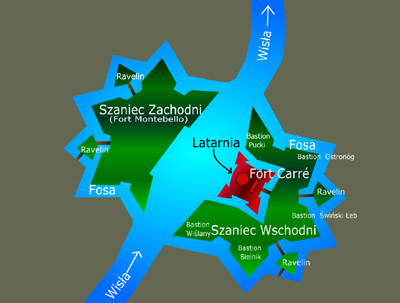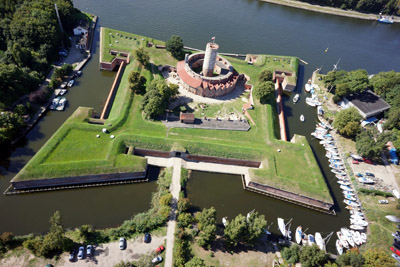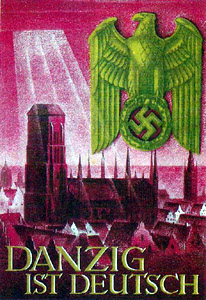 |
Twierdza Wisloujscie
Gdansk, Poland
|
|
 |
Constructed: 1584 - 1602
Used by: Poland, France, Prussia
Conflicts in which it participated:
Polish-Swedish War,
War of Polish Succession,
War of the Second Partition
Napoleonic Wars
Also known as: The Lantern
|
Since folks first realized they could float on water if they put wood under them, the harbor at Gdansk has been a busy busy place.
The city was officially founded in 997AD, and Westerplatte, the isthmus past which one had to sail to get to Gdansk on the Vistula River, was early identified as an excellent spot to fortify.
|
 |
|
|
Gdansk (also known by its German name, Danzig) developed into one of the most important ports on the Baltic. In 1301 the city was taken over by wicked Danish princes, who were ousted by Teutonic Knights that had been hired by Polish nobles. Once cleansed of Danes, however, Gdansk found itself possessed and being colonized by those same Teutons, as Teutons will do. It wasn't until the knights were finally dislodged in 1454 that permanent fortifications were first built to protect Gdansk.
|

The plan for improvements to Twierdza Wisloujscie around 1660. The starfort part is here identified as "Fort Carré," which is not to be confused with Fort Carré in Antibes, France: This is merely a reference to the style of the fort itself. Carré in French means "square," which is essentially what this fort is, once you take away the corner bastions. Latarnia means lantern, a reference to the fort's lighthouse. |
 |
In 1482 the fort's cylindrical brick tower was constructed, intended both as a defensive post and a lighthouse to help direct harbor traffic. The light was supplied by a fire kept roaring atop the tower, tending which must have been a delight.
When Poland picked another fight with the Teutonic Knights in 1519, Gdansk's brick tower was considered insufficient to the task of defending the port, so wooden fortifications were built around it. These were replaced in 1562 with a three-story casemated brick ring.
Though certainly not yet a starfort by any stretch of the imagination, the Lantern (as the fortification was known) successfully withstood besiegement by the forces of the Lord of Transylvania, Stefan Batory (1533-1586), in 1577.
|
|
|
This arrangement of brick circular things finally achieved starfort status at the beginning of the 17th century, thanks to Dutch architect Antoni van Obberghen (1543-1611). Van Obberghen arrived in Gdansk in 1586 with the accomplishment of already having done some work on the particularly pointy starfort Kronborg in Denmark, in 1577. Van Obberghen's presence in Gdansk began what became known as the Gdansk Renaissance, which was entirely constituted of the dude building stuff. He built Gdansk's town hall, arsenal, and more to the point of this page, the starfortish aspects that surrounded the lighthouse tower, which collectively became Twierdza Wisloujscie.
|
The Eastern Entrenchment, which is labeled Szaniec Wschodni in the graphic above, was constructed from 1624 to 1626: This was to defend against a landward attack, assumedly by the dastardly Swedes. Likewise, the Western Entrenchment was built on the other side of the river, and all of these additions were updated and kept ready for action through the 18th century.
The Polish-Swedish War (1626-1629) did indeed bring Swedes to Gdansk, but fortunately only in the form of a fleet that was beaten back by the Twierdza of our current interest. Sweden lost two ships in the Battle of Oliw, which took place on November 28, 1627, and was a surprise upset for the world-class Swedish Navy.
|
 |
Twierdza Wisloujscie's citadel, which is essentially a series of un-militant-looking buildings around the lighthouse. |
|
A map from 1733 shows no less than four additional starforts, in addition to Twierdza Wisloujscie, had been built to defend Gdansk, the city center of which was fortified as well. As was frequently the case, all of this fortification amounted to nothing but a long siege. In 1734 Catherine the Great (1729-1796) sent Russian troops Gdansk because she was unhappy that Stanislaw Leszczynski (1677-1766) had been made king of Poland (she had been hoping for someone more malleable to her political desires).
France entered the fray on the side of Poland, and sent troops to lift the siege. May 27, 1734, was the first time ever that French and Russian troops had at each other, and this historical event was not a happy one for the French. Twierdza Wisloujscie was frequently bombarded by the Russian fleet during the siege, which ultimately lasted 135 days. Russia captured Gdansk, though at the cost of 8,000 men.
|
|

Twierdza Wisloujscie from the air. Thanks to Opegieka for providing this great shot!
|
 |
In 1793 Gdansk was annexed by Prussia, after the War of the Second Partition (1792). Our Twierdza reportedly put up some sort of a fight, but was overwhelmed. The French also overpowered the fort in 1807, and then the Prussians returned in 1814 and, just for kicks, violently captured the Twierdza one last time.
During the French period, the Western Entrenchment was improved to the point where it was awarded its own name, Fort Montebello. This may have been in honor of the Battle of Montebello, fought on June 9, 1800, in which the French decisively beat the Austrians in northern Italy, in what was considered a "glorious victory." Just the sort of thing one might wish to name a starfort after.
|
|
|
Gdansk (though more properly when referring to the city in this time period we should say Danzig) became the capital of the province of West Prussia, and then part of the German Empire in 1871. The defense of Danzig's harbor increasingly fell to new Prussian fortifications built right at the mouth of the Vistula River, on Westerplatte.
|
|
The "helmet" that crowned the top of Twierdza Wisloujscie's tower, assumedly made of metal, was struck by lightning and destroyed in 1889. It was replaced by a cone made of slate, which shielded those in the Lantern until 1945 when the Red Army came rollin' through.
Gdansk was relatively untouched by the First World War (1914-1918), and upon the completion of that war, #13 of US President Woodrow Wilson (1856-1924)'s Fourteen Points was that Poland should be reconstituted as an independent nation, with free access to the Baltic Sea. Gdansk by then was more Danzig than Gdansk, with Germans far outnumbering Poles, so it became "the Free City of Danzig," through which Poles could come and go, conducting their business through the port. The city was completely demilitarized, which included Twierdza Wisloujscie - although surely by 1918 nobody considered the fort to be a true defensive entity any longer, militarized or un-.
The Second World War (1939-1941) actually began with the German Kriegsmarine battleship SMS Schleswig-Holstein shelling Polish forces on Westerplatte on September 1, 1939. Once Germany did away with the city's defenders over the next seven days, Danzig became part of Germany again.
|
 |
 "Danzig is German," lest there be any doubt. This did Gdansk precisely no good whatsoever when the pissed-off Soviet army arrived. "Danzig is German," lest there be any doubt. This did Gdansk precisely no good whatsoever when the pissed-off Soviet army arrived. |
|
For a variety of excellent reasons, the Red Army was in a collectively foul mood by the time it got to Danzig on March 30, 1945. The Soviets destroyed what was left of the city after years of Allied bombing. Twierdza Wisloujscie was razed in this orgy of destruction. Much of the Twierdza was reconstructed in the 1960's, at least partially thanks to subsidies from the USA. Since 1974 the fort has been administered by the Gdansk History Museum. Archaeological digs at the Twierdza occur annually, as I was recently informed by starfort fan Piotrek Gomulski, who volunteered for this service in 2013. Please visit Twierdza Wisloujscie's Facebook Page for up-to-date info on the fort and its events!
|
|
|
|
|
|
 |




